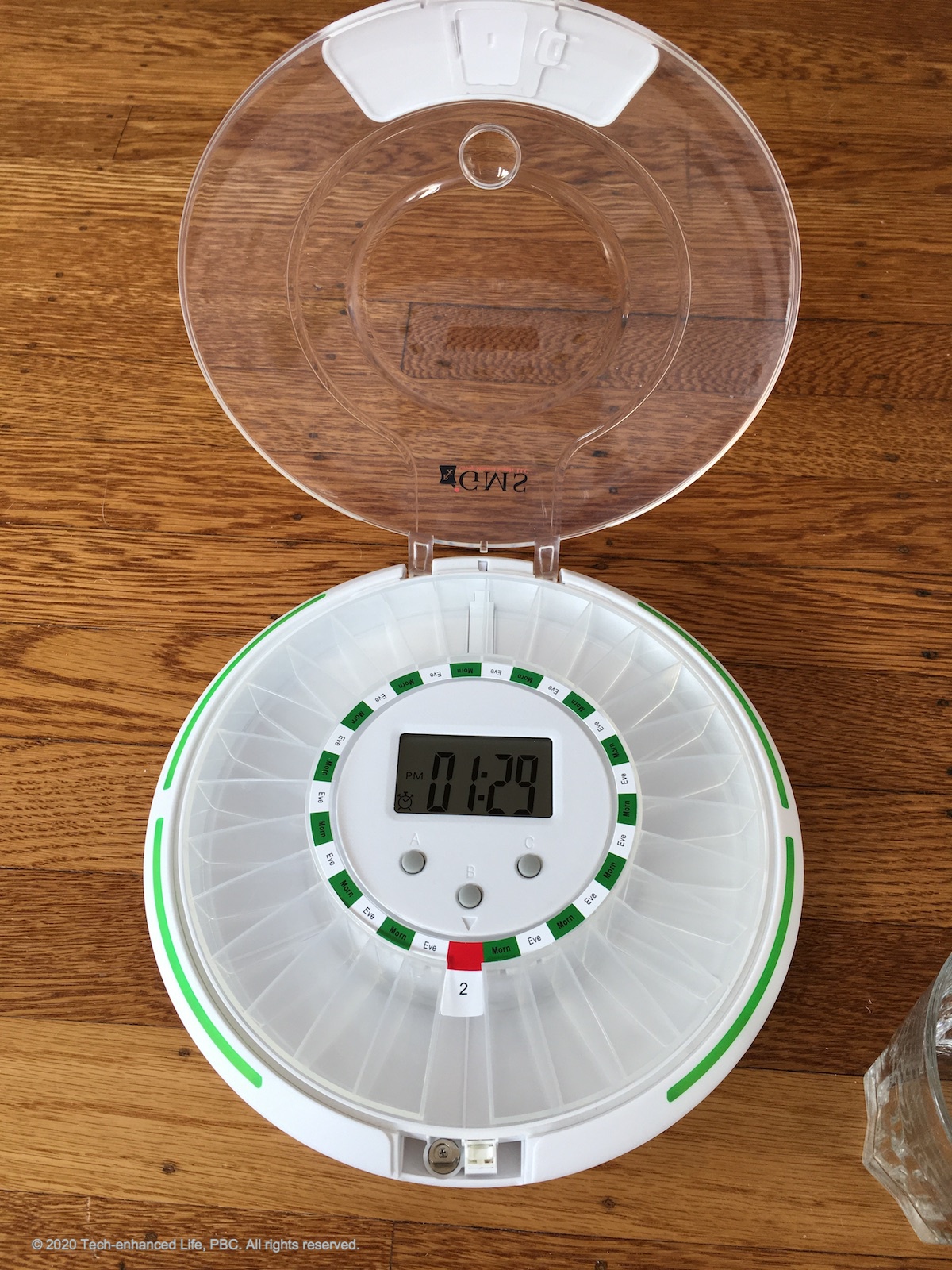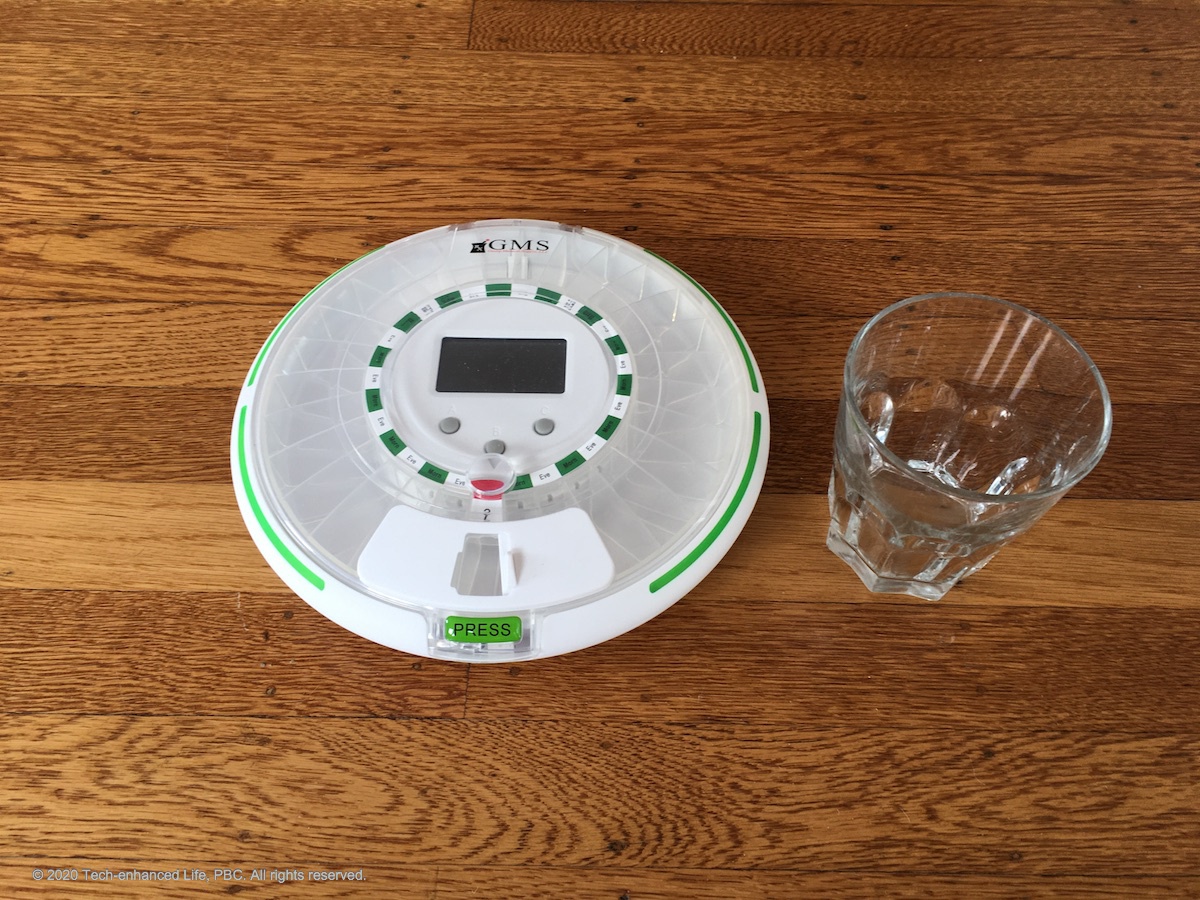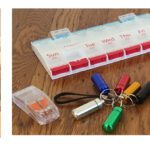GMS Automatic Pill Dispenser : Review
By: Editorial Team | Posted: January 25, 2020 | Updated: February 18, 2025
The Basics
- Product: Automatic Pill Dispenser
- Company: GMS
- Review Date: Q12020
Where to buy it or learn more*:
Discount for Tech-enhanced Life readers:
- Discount code:
- Discount amount:
[* affiliate relationship: When you buy through our links, we may earn a commission. Learn more]
Analyst Summary: GMS | Automatic Pill Dispenser
The GMS (Group Medical Supply) Pill Dispenser is designed to help you improve your adherence to the medication regimen prescribed by your healthcare providers. It does that by helping to organize your medication; and remind you which pills to take and when to take them.
The GMS (Group Medical Supply) Pill Dispenser is designed to help you improve your adherence to the medication regimen prescribed by your healthcare providers. It does that by helping to organize your medication; and remind you which pills to take and when to take them.
This product was included in a comparative analysis of the entire class of automatic pill dispensers. If you are not sure yet whether this product is the one you need, that comparative evaluation should help you understand which pill dispenser will work best for your life situation.
This product is cheaper, but has less features, than most of the products we reviewed in that work. It does NOT handle the organizing of the pills (the “filling”) for you. You need to do that yourself. And it is limited to 28 “pill compartments”, which means one week of 4 doses per day for example. And it has very limited capability to track adherence or notify caregivers.
The use case that makes the most sense for this product is when one person has the job of “filling” a person’s pill containers, and the person who needs those pills (the Dispensee) needs to be prevented from changing the medication, or taking the wrong medication at the wrong time. And when either cost or simplicity is important. And when the medication regimen is fairly simple, and relatively unchanging.
Which Medications Can It Handle?
This product can handle any “pills”. It is not suitable for liquids or medication that needs refrigeration, nor does it include ways to remind you of these medications “outside” the dispenser.
User Interface (UI)
One of the common scenarios in which these types of products will be used involve two different people. One, which we call the “dispensee”, is the person who consumes the medication, and who needs to interface with the machine when it is time for the medications to be dispensed.
The second, which we call the “filler”, is the person who worries about putting the right medication into the system every week or month, and who sets up the “dispensing schedule” according to whatever schedule has been prescribed by the physicians of the dispensee.
In many scenarios, the filler will be a caregiver, or spouse, or adult child of the dispensee. However there will also be situations in which the dispensee also performs the job of the filler (i.e. when you worry about your own medication management instead of involving someone else).
This product operates rather like a conventional pill box, except that it is circular, and the Dispensee can not open the individual pill compartments. The compartments inside the system rotate, so that the appropriate pills are always under the “dispensing slot”.
When it is time for a “dose”, it attracts your attention with flashing lights and noise. To “get the pills” you tip it forward, and take the pills for that dose from the dispensing compartment.
It has a companion “App” which can be used to program the medication schedule. In the model we purchased, the App pairs with the system using Bluetooth and thus only works when your phone and the pill dispenser are near each other. There is a more expensive version that connects to the internet via WiFi, and for that version the App connects from anywhere (via the Internet).
Programming Medication Schedule
The first step in using this product after setting it up is to set up “alarms” that govern how often the product will dispense pills. You can set up to six alarm times per day, and you can do this either with buttons on the pill dispenser itself or via the App.
When each alarm goes off, the pill box internal mechanism rotates and allows the next “pill group” to be accessed.
Once you have set the alarms, you need to put the appropriate pill groups into the correct slots in the machine.
Limits on Complexity of Regimen
You can have up to six “dose times” per day, and at each dose time you can have multiple pills, governed by the size of each pill container compartment. See “Capacity” below.
Filling (Putting Pills into the Device)
In our opinion, how well the product handles the “filling” step is a key differentiator between various pill dispenser systems and smart pill boxes. This product works just like a conventional pill box as far as filling is concerned.
How Filling Happens
You use a key to “unlock” the lid to the product, which lifts up and exposes a wheel of pill compartments. You manually place the appropriate pills for each dose into the different compartments. Getting the right pill in the right place is entirely up to whoever has the role of “filler”.
For straightforward medication regimens, this is not so complicated. For regimens where each dose needs different groups of pills, we think it would be easy to make a mistake with this type of product (no more so with this product than with conventional pill boxes of course).

Caption: GMS Pill Dispenser being filled.
Capacity
The product has 28 pill compartments, and so could handle one dose per day for a month, four per day for a week and so on. It can handle as many as 6 alarms per day. Each “compartment” can take up to 15 of the “standard” pills (1) we used to compare capacity in our evaluation.
| Product | Doses /day | Pill “compartments” | Standard Pills / compartment | Total pill capacity |
|---|---|---|---|---|
| GMS | 6 | 28 | 14 | 392 |
See Automatic Pill Dispensers: Hands-on Evaluations for a chart with “capacity” comparisons between this and the competing products.
Medication Database, Scanner
This product does not have these features.
Early / Late / Missed Doses / Flexibility
If you “miss” a dose, or need to take doses out prior to the correct dose time, the options are a bit limited. If you have the Caregiver “key”, you can easily open up the compartments and take pills out manually.
Separation between Dispensee and Filler Roles
One of the key “features” of this product, compared to a conventional pill box, is that the “Dispensee” can not get into the pill box to adjust medication, or to take any medication other than that appropriate for the specific dose time. So for situations where a clean separation is needed between Dispensee and Filler roles, this product does a good job of accomplishing that.
Physical & Cognitive Impairments
For someone with reasonably good cognition, and no huge physical impairments, we thought this product was very easy to use. But we question the benefit over a conventional pill box for that person.
This product appears to be specifically designed for situations in which people with impaired cognition need a way to take their medications (with someone else doing the “filling”).
For people with tremor, poor eyesight, or severe arthritis, we did not see any especial problems.
“Time to Refill”
There are no clever features to help remember to refill.
Set Up & Connectivity
Connectivity
This product does not connect to the Internet. It does connect via Bluetooth to its companion “App”. Pairing the product and the App was straightforward.
There is a more expensive version of the product that has WiFi connectivity, which should allow better notifications to caregivers. We did not evaluate the WiFi version.
General Setup
Setting the system up for the first time requires turning it on, and pairing “your” product with the App, or setting up the alarms manually using buttons on the product. As “setup” routines go, it seemed fairly straightforward.
Portal or App
The App is quite limited in function. You can set or change the six “alarms”. And you can see a “report” which records when various doses were taken. It needs to be close to the pill dispenser to work (due to Bluetooth connectivity).
Remote medication adjustment
You cannot make any changes remotely.
Caregiver Monitoring
The product clearly has in mind the scenario of a caregiver or family member who is involved in helping to manage the medications of someone else (an older adult for example).
However, the App can NOT send notifications if the dispensee has not taken medication at the right time. The WiFi version of the product claims to address this limitation, but we did not test it.
Additional Features & Details
Security & Anti-tampering
Dispensee with Cognitive Impairment
The pill compartments in the system itself are locked by a key. Adjusting medication schedules (the alarms) happens via the App, which can be limited to Caregivers if that is appropriate.
“Others” Using your Meds
There is a separate situation which some of the products in this category worry about. That is the situation in which the wrong person takes “your” pills. A topical example is in the case of opioids, for example, where you do not want others with access to the house to be able to take “your” opioids. As best we can see, this product does NOT address this situation.
Hacking the System
Being unconnected to the Internet, this machine should be immune to most hacking scenarios.
Power & Battery Backup
The system is powered by a battery. It can also be plugged into a regular power outlet.
Vacations & Trips & Leaving the House
The relatively small size of this product is a big advantage. It would be easy to pack this in your carry-on or suitcase and take it with you.
Aesthetics
The overall look and feel of the product is not too ugly. It is reminiscent of other “pill boxes” in overall appearance — plastic, relatively small. It is by far the smallest of the products we evaluated in our “automatic pill dispenser” comparative evaluations. It even has a sort of “tech vibe” — with white and green color scheme, and lights.
It is a disc like a flying saucer, with diameter about nine inches and height about 2-3 inches.
Pricing
We bought this product in Q4 2019 on Amazon for roughly $80. The WiFi version was available on Amazon for $200 in Q1 2020.
Manual, Support, Training
There is a (paper) “setup brochure”. It seemed adequate, and mentions some videos on a website for extra tips.
Languages: Documentation and the interface seem to only come in “English”.
References
(1) The pill we chose as a standard was on the larger side actually. It was oblong in shape and roughly 17mm long by 7mm wide. So, to avoid confusion, this is not “standard” in any widely acknowledged sense. It is just what we chose to use.
Where to buy it or learn more*: (this takes you away from our website)

Discount for Tech-enhanced Life readers:
- Discount code:
- Discount amount:
[* affiliate relationship: When you buy through our links, we may earn a commission. Learn more]
*Disclosure: The research and opinions in this article are those of the author, and may or may not reflect the official views of Tech-enhanced Life.
If you use the links on this website when you buy products we write about, we may earn commissions from qualifying purchases as an Amazon Associate or other affiliate program participant. This does not affect the price you pay. We use the (modest) income to help fund our research.
In some cases, when we evaluate products and services, we ask the vendor to loan us the products we review (so we don’t need to buy them). Beyond the above, Tech-enhanced Life has no financial interest in any products or services discussed here, and this article is not sponsored by the vendor or any third party. See How we Fund our Work.

in reviews there is much
in reviews there is much discussion about small pills redistributing into incorrect slots or getting caught in the mechanism and preventing the disk from turning fully. Did you see this in your testing?
Let me clarify. Reviewers
Let me clarify. Reviewers are stating that when the unit is turned upside down to dispense the pills, small pills from other slots can work their way though the gap between the separators onto the top top. Then when the device is right-sided those loose pills can land back in the wrong slots or work they way into the turning mechanism. Did you see this with your testing and how small do the pills have to be for this to occur? Some of my dad’s pills are quite small and his cognitive ability may not catch this occurring.
The unit will no lock,
The unit will no lock, appears stripped. What can be done?
Our 2x per day (14 day cycle)
Our 2x per day (14 day cycle) offered the red colored ring (2x) as the 1st dose for day 15, therefore the entire schedule is now off by 1/2 a day. How do you get around this? I had to manually unlock the dispenser to rotate it past the red, locked 2x per day indicator to reschedule it. It appears this is the only work around to that issue. Please advise if you have a better solution.